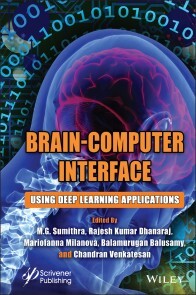Brain-Computer Interface
173,99 €*
Lieferzeit Sofort lieferbar
Brain-Computer Interface, Wiley
Using Deep Learning Applications
Von M.G. Sumithra, Rajesh Kumar Dhanaraj, Mariofanna Milanova, Balamurugan Balusamy, Chandran Venkatesan, im heise Shop in digitaler Fassung erhältlich
Using Deep Learning Applications
Von M.G. Sumithra, Rajesh Kumar Dhanaraj, Mariofanna Milanova, Balamurugan Balusamy, Chandran Venkatesan, im heise Shop in digitaler Fassung erhältlich
Artikel-Beschreibung
BRAIN-COMPUTER INTERFACEIT COVERS ALL THE RESEARCH PROSPECTS AND RECENT ADVANCEMENTS IN THE BRAIN-COMPUTER INTERFACE USING DEEP LEARNING.The brain-computer interface (BCI) is an emerging technology that is developing to be more functional in practice. The aim is to establish, through experiences with electronic devices, a communication channel bridging the human neural networks within the brain to the external world. For example, creating communication or control applications for locked-in patients who have no control over their bodies will be one such use. Recently, from communication to marketing, recovery, care, mental state monitoring, and entertainment, the possible application areas have been expanding. Machine learning algorithms have advanced BCI technology in the last few decades, and in the sense of classification accuracy, performance standards have been greatly improved. For BCI to be effective in the real world, however, some problems remain to be solved. Research focusing on deep learning is anticipated to bring solutions in this regard. Deep learning has been applied in various fields such as computer vision and natural language processing, along with BCI growth, outperforming conventional approaches to machine learning. As a result, a significant number of researchers have shown interest in deep learning in engineering, technology, and other industries; convolutional neural network (CNN), recurrent neural network (RNN), and generative adversarial network (GAN). AUDIENCEResearchers and industrialists working in brain-computer interface, deep learning, machine learning, medical image processing, data scientists and analysts, machine learning engineers, electrical engineering, and information technologists. M. G. SUMITHRA, PHD, is a professor at Anna University Chennai, India. With 25 years of teaching experience, she has published more than 70 technical papers in refereed journals, 3 book chapters, and 130 research papers in national and international conferences. She is a Nvidia Deep Learning Institute Certified Instructor for "Computer Vision".
RAJESH KUMAR DHANARAJ, PHD, is a professor in the School of Computing Science and Engineering at Galgotias University, Greater Noida, India. He has contributed around 25 authored and edited books on various technologies, 17 patents, and more than 40 articles and papers in various refereed journals and international conferences. He is a Senior Member of the Institute of Electrical and Electronics Engineers (IEEE).
MARIOFANNA MILANOVA, PHD, is a professor in the Department of Computer Science at the University of Arkansas, Little Rock, USA. She is an IEEE Senior Member and Nvidia’s Deep Learning Institute University Ambassador. She has published more than 120 publications, more than 53 journal papers, 35 book chapters, and numerous conference papers. She also has two patents.
BALAMURUGAN BALUSAMY, PHD, is a professor in the School of Computing Science and Engineering, Galgotias University, Greater Noida, India. He is a Pioneer Researcher in the areas of big data and IoT and has published more than 70 articles in various top international journals.
V. CHANDRAN holds an M.E degree in VLSI Design from Government College of Technology, Coimbatore, and is a Nvidia Certified Instructor for Deep learning for Computer Vision.
Artikel-Details
Anbieter:
Wiley
Autor:
Balamurugan Balusamy, Chandran Venkatesan, M.G. Sumithra, Mariofanna Milanova, Rajesh Kumar Dhanaraj
Artikelnummer:
9781119857648
Veröffentlicht:
31.01.23
Seitenanzahl:
320

